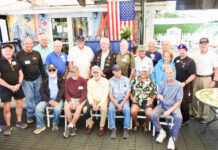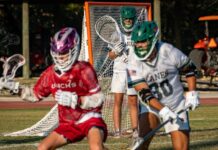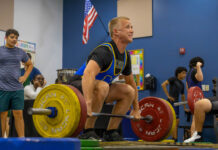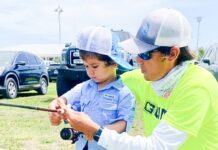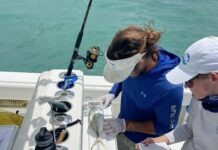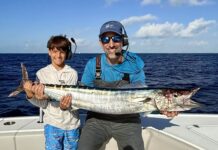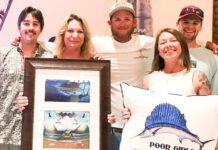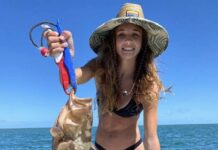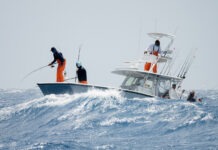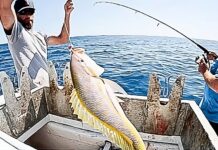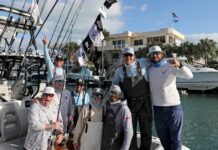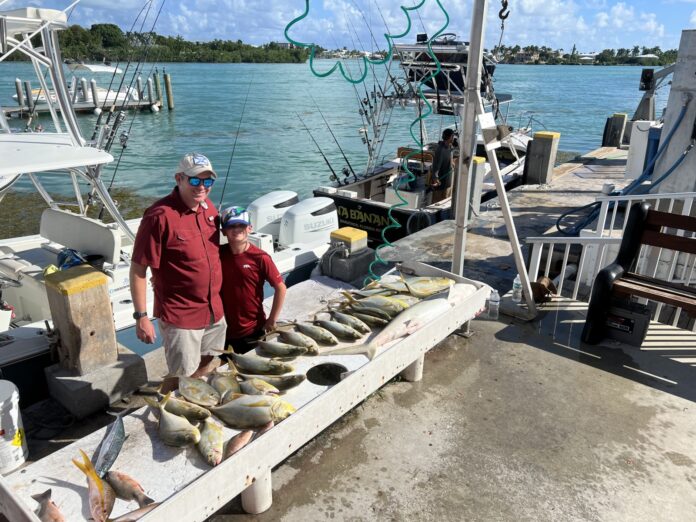
Fishermen have been keeping their fishing spots secret since the beginning of time. These spots are so sacred to some captains and anglers that I’ve seen fights over them. I’ve seen captains make charter clients leave their cell phones in their bags and even tell them to not look at the GPS.
I added up all the spots that I have for the Middle Keys on my GPS and realized I have over 15,000 marked fishing holes. Realistically, I can only fish five or six of them a day. So it’s fair to say that at this time in my life, I have more fishing spots than I can physically fish in a lifetime. I do have a few dozen go-to spots that I fish on a consistent basis, and every once in a while I’ll go to one I’ve never fished or haven’t fished in years and throw a Hail Mary pass. There are some wrecks and ledges marked on my GPS that I hold sacred.
At the end of the day, a fisherman can have all the numbers in the world, but he or she must know when to fish them and how to fish them, which is a whole different story. I’m not going to share latitude and longitude numbers with you today, but I am going to give an up-to-date fishing report. I’m going to tell you what’s biting and how and when to fish for specific species.
- Spanish and cero mackerel: Find hard bottom in 10 to 12 feet of water 10 to 12 miles from middle Marathon in the Gulf of Mexico and anchor up. I would chum heavy with a chum block in a chum bag off the back of your boat. Use quarter-ounce jig heads with green and white feathers and a tipped live shrimp, jigging and reeling through the middle of the water column. The best time to fish for Spanish and cero mackerel is when the sun is the brightest between 11 a.m. and 3 p.m.
- Yellowtail snapper, mutton snapper, lane snapper, black grouper, hogfish, grunts and yellow jacks: These fish are grouped together right now, in shallower water than usual. Anchor on 20- to 25-foot ledges only four or five miles offshore in the Atlantic Ocean. Locate mounds on Google Earth which go from as shallow as six or eight feet at the peak of the mound to levels below 30 feet. Chum heavy with green tournament chum. There are several of these mounds in Hawks Channel off the coast of Marathon. Anchor so you are away from the mound, with your chum and bait flowing toward the peak of the mound. The best bait this time of year for these mound fish are live jumbo-sized shrimp hooked on heavy, medium or light jig heads, depending on how heavy the current is. You want to choose a jig head that will stay in the middle of the water column. Choose a jig that’s too big, and your shrimp will sink immediately to the bottom and hold on the bottom. Too small, and the current will keep your shrimp on the surface. The stronger the current, the heavier the jig head. Once your shrimp gets to the bottom, jig it in slowly and wait for the hit. Any time of day or night is good on these mounds, but it’s best when the current has a good flow. When it’s slack tide and your chum line is running back up your anchor line, the bite can be slow. Keep in mind that hogfish are catch-and-release only right now, and we only have a few weeks left until grouper season is over at the end of December.
- Sailfish: Target sailfish from 25 to 225 feet of water. The most effective way to catch a sailfish this time of year is by using a kite with a live goggle eye dribbling on the surface. Another popular technique this time of year is by bump trolling a ballyhoo.
- Snook, redfish, trout, juvenile tarpon and mangrove snapper: We like to target them near thick mangroves using live pilchards and pinfish. The best time to fish for the species this time of year is early in the morning or late in the afternoon.
- Cobia: When the weather cools down, we like to target cobia 25 to 55 miles out in the Gulf of Mexico at wrecks and springs. The best bait for these cobia are hand-sized pinfish. If you can’t get live pinfish, or want to target cobia on strictly artificial baits, I recommend a white and red flare hawk feathered jig. Many times, cobia can be spotted on the surface and sight fished. The best way to find Cobia on the surface is during slack or slack-ish tide in the middle of the day.
- Wahoo: Most wahoo this time of year are targeted on the Atlantic side from 90 to 300 feet deep over wrecks, drop-offs, color changes and patch reefs. The best way to fish for wahoo this time of year is with a small live bonita free with no weight over the wreck. The best time to target them is early in the morning and late in the afternoon. We are also having success trolling pink-and-black Nomad lures at six knots and tormentor purple plastic weighted squids at 11 to 14 knots using an in-line cable weight. The ideal situation for harvesting a wahoo is during a full moon with clear skies, and very little wind and waves.
To book a charter with Ana Banana, call or text Capt. Joel at 813-267-4401 or Capt. Jojo at 305-879-0564, or visit anabananafishing.com.







